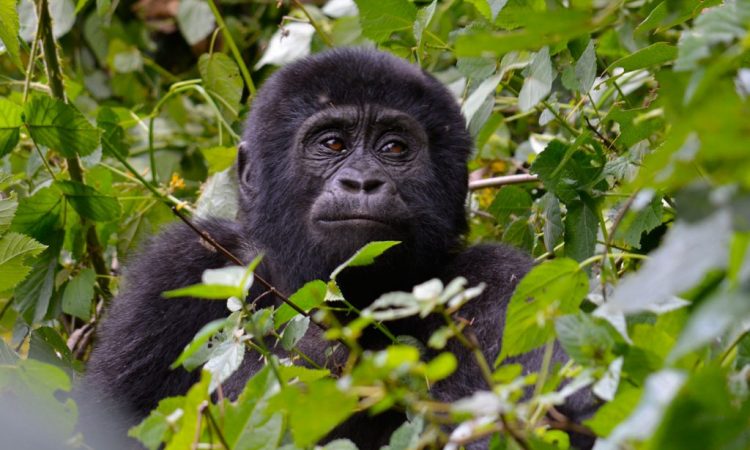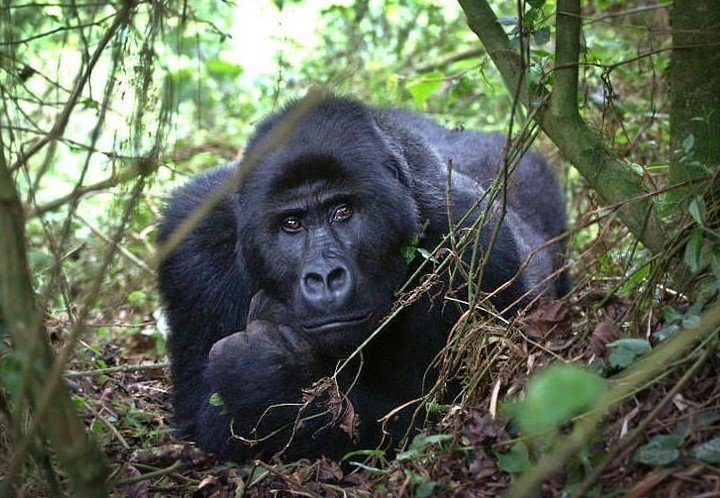Things to do when encountering gorillas in Bwindi Impenetrable National Park: “What should I do if I come across a gorilla?” This is a popular query from visitors planning to observe gorillas in the wild. It can be frightening to come face to face with a 400-pound (200kg) silverback gorilla, the world’s strongest animal, in the dark African bush.

Before going out into the bush, you are briefed on how to behave with the gorillas to ensure that they are not agitated by your presence and to protect you from any gorilla backlash. The following advice is based on the assumption that you will encounter a habituated gorilla during your gorilla trekking expedition in Rwanda and Uganda.
Nonetheless, various gorillas have varied personalities, and the guide will always warn you about particular cantankerous members of the gorilla family. Here are some suggestions and pointers for what to do if you come across a gorilla during your Uganda gorilla trekking safari in Bwindi Impenetrable national park;
- Keep a 7 Meters Distance Between You and the Gorillas.
It is recommended that you stay at least 7 meters (23 feet) away from the gorillas at all times. This is done to avoid stressing the gorillas, as well as to maintain “social distance” from the gorillas in order to avoid disease transmission between gorillas and humans.
Yet, curious and lively youngsters may approach you to observe you. Sometimes an adult will just enjoy where you are and will move, sit, or stop right next to you. Step back until you are about seven meters away, or keep going back as long as the gorilla is approaching you until you can no longer move. If you are in the path of a gorilla that is approaching you, step aside and let it continue.
- Avoid eye contact with the silverback gorilla
Making eye contact with the silverback gorilla indicates to him that you are threatening his supremacy. He’ll become irritated and charge at you. Just turn away as soon as you catch yourself staring at the silverback gorilla. Of course, staring into the blazing large reddish-brown eyes of this gentle giant is enticing and hypnotic.
If you chance to glance into a gorilla’s eyes, take a minute to completely savor the sensation before taking your sight away from the gorilla’s eyes and looking down. This tells the gorilla that you are not a threat, and everyone can rest.
- Disable the Flash light on your Camera.
Turn off the flash from the camera before encountering the gorillas. Flash from the camera disorients the gorillas, scaring them away. It may also provoke the silverback gorilla to charge.
- Avoid making sudden Movements when around the gorillas.
While in the presence of several gorillas, avoid making unexpected movements such as sprinting or plucking branches. If the gorillas feel threatened, they may escape or elicit a charging charge from the silverback.
- Stay close to your group
Avoid isolating yourself from the rest of your tracking group. Stay near the group so that the silverback can quickly identify you if he becomes irritated.
- Speak in a low tone
When on your gorilla trekking experience in Bwindi impenetrable national park, ensure to keep your voice down so as not to agitate the gorillas, as they are sensitive to loud noises and can become aggressive when they get scared or feel threatened.

- Crouch and look down in case silverback charges at you.
This is uncommon, although it has happened if you go too close to him or any of his members, or if you do anything that irritates him. If the silverback charges at you, be calm and do not flee. Crouch and look down.
- Do not eat in the midst of the gorillas.
Carry no food or dine near the gorillas. The gorillas eat only vegetation found in their natural environment. Any unfamiliar meal might disturb their digestive system and kill them.
What to observe when you are with the gorillas.
Gorillas communicate using vocalizations, body postures, and particular behaviors. For example, if a gorilla pushes another gorilla out of a resting or eating position, he is the more dominant one. Researchers record such displacements and utilize the data to figure out the male hierarchy and comprehend group behavior.
Gorillas frequently groom each other. This is a soft gesture in which the hair is cleaned to eliminate dust, leaves, and debris. Seeing a mother gently cleaning her young is one of the most memorable experiences for many gorilla tourists.
You can often hear gorillas making “belch” vocalizations, which are guttural sounds that mean “all is well,” while they sleep, relax, play, and groom. When a dominating silverback belches, the other gorillas respond. When gorillas are eating a particularly good feast, they may create belching sounds, which might crescendo into a chorus of numerous gorillas spewing at different pitches, almost like singing! Trackers and guides frequently emulate the belch sound to communicate their presence in a calm manner.
The dominating silverback is usually the first to conclude the resting phase and will then decide where the group will go next. When he decides to move, all of the gorillas follow in a line, with the most dominant ones in front, to the next feeding spot. You’ll be shocked at how rapidly a gorilla troop may retreat into the jungle after leaving a resting session.
Yet, not all gorilla habits are calm. Antisocial conduct is also noted, especially when they encounter another group or a lone guy. Males frequently initiate interactions by cheating beats, hooting vocalizations, pounding the ground, or breaking plants. Gorilla males exhibit in a strut position, with straight stiff limbs, arched backs, and heads swaying side to side. Displays and strut stance stances are used to impress the opponent, and the engagement will usually end without a physical battle. Displays can also be done inside a group, such as when a guy tries to impress ladies!
Spending time with mountain gorillas in Bwindi impenetrable forest national park is without a doubt one of the most unforgettable wildlife experiences on the planet. Being in and around a gorilla family will undoubtedly leave you with memories and impressions that you will never forget. With just 880 mountain gorillas left, travelers must also be mindful of their own conduct when interacting with the gorillas in order to avoid any potential harm to the gorillas. This includes keeping the necessary distance, coughing into your arm, and not spitting or eating in the forest.


